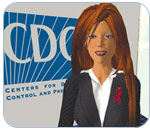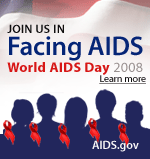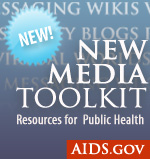Facing AIDS for World AIDS Day
World AIDS Day is in less than a week (December 1)! In addition to our Bloggers Unite and Second Life activities, AIDS.gov invites you to join us in using social networks to help reduce stigma around HIV/AIDS and to promote HIV testing.
Why use social networks? Many people are already using social network sites to share information about issues that are important to them. For example, (Product) RED’s, MySpace page  has over half a million friends and has another 100,000 fans on Facebook
has over half a million friends and has another 100,000 fans on Facebook  . MySpace created MySpace Impact
. MySpace created MySpace Impact  , “a channel for the causes and campaigns MySpace users care about.” Facebook Causes
, “a channel for the causes and campaigns MySpace users care about.” Facebook Causes  , created by Project Agape
, created by Project Agape  , were developed to organize people for collective action - and Causes is now on Myspace
, were developed to organize people for collective action - and Causes is now on Myspace  as well. According to Facebook, “the real power of Causes… is that supporters of the cause can easily multiply their impact by inviting their friends to join and donate to the cause.”
as well. According to Facebook, “the real power of Causes… is that supporters of the cause can easily multiply their impact by inviting their friends to join and donate to the cause.”
How is AIDS.gov using social networks for World AIDS Day? We’ve launched the “Facing AIDS for World AIDS Day” campaign. It’s simple - take a photo of yourself wearing a red ribbon and, on World AIDS Day, put the photo on your social networking site (such as Facebook or MySpace), blog, Twitter page, or website. We also have web badges that you can share with your friends and colleagues.
What is the response to Facing AIDS so far?
We have been watching our web badges spread on the Internet, and seen the number of photos grow in our World AIDS Day Flickr Group  . People have been tagging the geographic location on Flickr - which shows the locations from which they are uploading their photos - so we can see a map
. People have been tagging the geographic location on Flickr - which shows the locations from which they are uploading their photos - so we can see a map  of supporters joining together.
of supporters joining together.

Hygeia Philo, CDC’s Avatar
In addition, several of our Federal colleagues, such as those from the U.S. Centers for Disease Control and Prevention, the Office of Minority Health, and the Office on Women’s Health are getting the word out by adding the “Facing AIDS” web badges to their websites. Others, such as the HIV/AIDS Bureau of the Health Resources and Services Administration, have featured the event in their newsletters. Many of our Twitter friends are retweeting  about the campaign, and we are encouraging people to use the hashtag
about the campaign, and we are encouraging people to use the hashtag  #WAD08 in their tweets so we can watch the conversation grow.
#WAD08 in their tweets so we can watch the conversation grow.
We’ve also seen the numbers of our recently launched “Facing AIDS World AIDS Day  ” Facebook Group grow. And several of our avatar friends from Second Life have posted photos, too!
” Facebook Group grow. And several of our avatar friends from Second Life have posted photos, too!
With one week left until World AIDS Day, will you join us in Facing AIDS for World AIDS Day 2008? If so, here’s how you can take action in five easy steps:

Michelle Samplin-Salgado, New Media Strategist, AIDS.gov
STEP 1: Take a photo of yourself wearing a red ribbon. No camera or time to take a photo? Instead, you can select one of our web badges (or any other red ribbon image).
STEP 2: Add the photo (or badge) to your social network profiles, Twitter, and/or blog in time for World AIDS Day. Leave it up for at least one week. Don’t have a profile in any of these places? No problem! You can go directly to Step 3.
STEP 3: Add your photo to the “World AIDS Day 08” Flickr group  ! If you tag the photo with your geographic location, together we can make a map and album of supporters around the world.
! If you tag the photo with your geographic location, together we can make a map and album of supporters around the world.
STEP 4: Use your wall, status, tweets or website to encourage HIV testing. To find an HIV testing site near you (in the U.S.), send a text message with your ZIP code to “KNOWIT” (566948) or visit: http://www.hivtest.org  .
.
STEP 5: Encourage your friends to do the same and to promote HIV testing!
We hope you will join us in using new media tools to recognize World AIDS Day 2008! Are you planning or participating in other World AIDS Day new media activities? If so, please let us know! And check back next week for a special World AIDS Day post.
If you enjoyed this post, please consider leaving a comment or subscribing to the feed to have future articles delivered to your feed reader or email.





Thank you for getting the message out. I have informed all of our coworkers to take pictures with red ribbons for our myspace and twitter profiles as well as a slew of others. The reason for commenting was to say thank you for raising so much awareness for AIDS. This website has been so extremely hellpful on getting the message out to so many people and everyone here would like to say thank you so much for what all your doing.
Posted by: Diesel Power | November 26, 2008 at 12:15 AM
You are doing a very good job. We informed all our contacts to join World AIDS Day. We placed a banner on our site and soon will develop a section related to hiv/aids.
Posted by: men health | November 27, 2008 at 12:44 AM
This is a great idea and I've added the topic to my blog today, December 1, 2008. Good luck!
Posted by: Robin | December 01, 2008 at 11:10 AM
AIDS: No Way Out
-Mohammad Khairul Alam-
-Executive Director-
-Rainbow Nari O Shishu Kallyan Foudation-
-24/3 M. C. Roy Lane-
-Dhaka-1211, Bangladesh-
-Email: rainbowngo@gmail.com-
-Web: www.newsletter.com.bd-
-Tell: 880-2-8628908-
-Mobile: 88-01711344997-
The epidemics in many countries of South Asia are now entering a new phase. One of the first populations to be affected by HIV in South Asia were injecting drug users. In areas where drug injection has been long established, such as Manipur in north-eastern India, HIV prevalence rates of over 40 percent have been recorded for several years. Several hundred thousand people infected during the explosive start of epidemics are becoming ill and are undergoing treatment. The treatment of infections becomes a great burden for the country concerned, because HIV/AIDS requires long-term and effective medical care, periodical hospital-based care and trained manpower to provide comprehensive healthcare services. For countries where resources are scarce, easy access to treatment and care remain very questionable and prohibitive for many PLWHAs. (people live with HIV/AIDS)
Globally, more or less 40 million people that are infected with HIV/AIDS, Every day 14,000 getting infected and 6,000 are young of them; approximately 95% live in severely resource-constrained settings. In 2005, there were 4.9 million new infected. That means every year add 4.9 million people swap over burden in globally which were potential in the before recent year. If this situation continues there will be burden people increase day by day, and country lost dynamic potential manpower. There is another important argument to take up the challenge: HIV/AIDS mainly affects adults in their productive prime, leaving the very young and old to cope alone. This severely hampers economic growth and development of countries concerned.
Some times poverty facilitates the spread of HIV/AIDS, but equally HIV/AIDS affect poverty. Generalizing HIV/AIDS into a problem of poverty will paralyze an effective and specific response to it. By nature of the population it affects, the economic and developmental impact of HIV/AIDS is likely to be much greater than that of other major infectious diseases or deadly diseases, It is parallel call epidemic other major deadly diseases such as tuberculosis, malaria, diarrhea etc.
Sex workers may be an at-risk population with circumstances and motivations that differ from other high-risk persons. This study shed light on how a person perceives being at risk. Views of ones’ sex partner(s) as the source of risk, rather than one’s own behaviour, appear to affect how people make sense of their sexual activity and decide on protective measures. For sex workers, due to their occupation, these processes induce them to self-identify as being at risk, while other high-risk persons may find denial easier to maintain. However, conditions of their occupation negate sex workers from making those changes most often made by other high-risk persons (fewer partners, monogamy, and consistent condom use). How this relates to getting tested for HIV, and factors that reduce testing differ between male and female sex workers, with economics and access being stronger factors among the female sex workers.
Bangladesh is a high prevalence of sexually transmitted diseases, particularly among commercial sex workers; there are available injection drug users and sex workers all over the country, low condom use in the general population. Considering the high prevalence of HIV risk factors among the Bangladeshi population, HIV prevention research is particularly important for Bangladesh. It is very awful, several organization in Bangladesh are working only to prevent HIV/AIDS but few of them like as ‘Rainbow Nari O Shishu Kallyan Foundation’ try to develop proper strategic plane, so should increase research based organization recently.
Sources: USAID, UNICEF, World Bank
Posted by: Mohammad Khairul Alam | December 14, 2008 at 03:26 AM
I think it is really a brilliant idea that you are taking advantage of social networking site to spread the awareness of AIDS since a lot of people are using the social networking site for almost everyday! I hope your message reaches to all over the world!! More people will take action to make a change because of your effort! Thanks!
Posted by: Miyakojima | January 22, 2009 at 10:20 PM